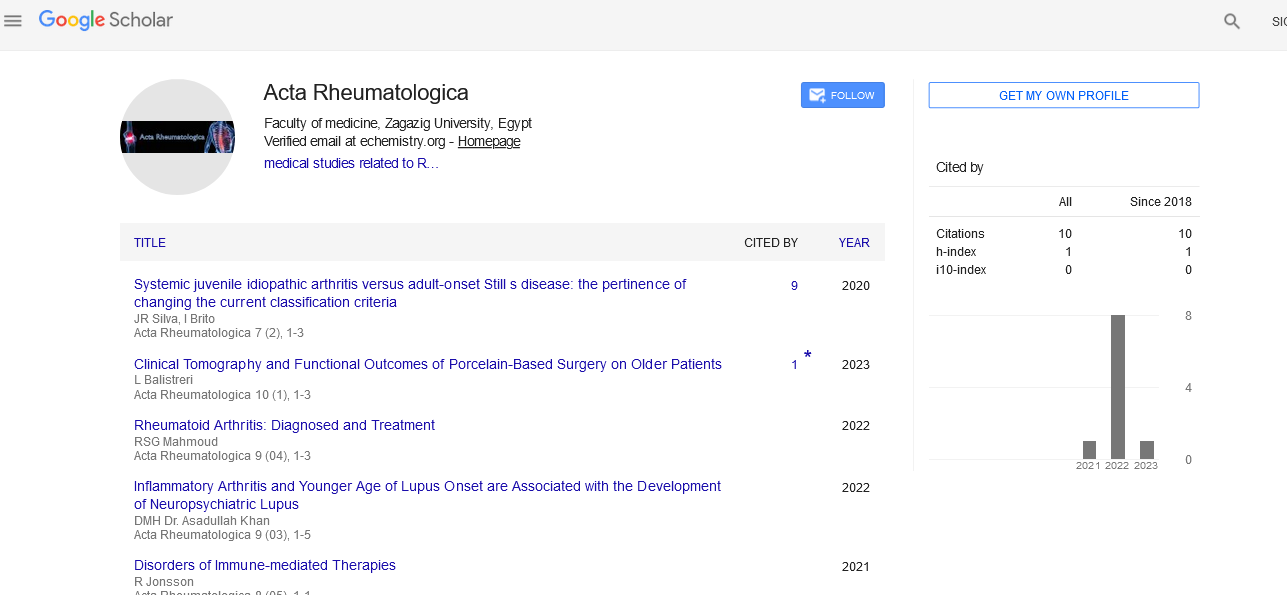Opinion - (2022) Volume 9, Issue 4
Signs and Symptoms of Ankylosing Spondylitis
Williams Matthew*
Department of Pathology, University of Utah, Utah, USA
*Correspondence:
Williams Matthew, Department of Pathology, University of Utah, Utah,
USA,
Email:
Received: 03-Aug-2022, Manuscript No. ipar-22-12499;
Editor assigned: 05-Aug-2022, Pre QC No. ipar-22-12499 (PQ);
Reviewed: 24-Aug-2022, QC No. ipar-22-12499;
Revised: 24-Aug-2022, Manuscript No. ipar-22-12499 (R);
Published:
31-Aug-2022, DOI: 10.36648/iparX.22.9.4.12
Perspective
Ankylosing spondylitis (AS) is a kind of arthritis that causes longterm
inflammation of the spine's joints. The joints where the
spine meets the pelvis are frequently impacted. Other joints,
such as the shoulders or hips, are occasionally involved. Eye
and gastrointestinal issues are also possible. Back discomfort is
a common symptom of AS, and it comes and goes. Ankylosing
spondylitis has a lengthy history, with Galen distinguishing it from
rheumatoid arthritis as early as the 2nd century AD [1]. Skeletal
evidence of the disease (ossification of joints and entheses
particularly of the axial skeleton, known as "bamboo spine") was
thought to be discovered in the skeletal remains of a 5000-yearold
Egyptian mummy [2].
However, a later report revealed that this was not the case.
Realdo Colombo, an anatomist and surgeon, described what
could have been the disease in 1559, while Bernard Connor
published the first account of pathologic changes to the skeleton
likely connected with AS in 1691 [3]. In general, the stiffness of
the afflicted joints worsens over time. Ankylosing spondylitis has
no known treatment. Treatments may alleviate symptoms and
prevent them from worsening. Medication, exercise, physical
therapy, and, in rare situations, surgery may be used. NSAIDs,
steroids, DMARDs such as sulfasalazine, and biologic medicines
such as TNF inhibitors are among the medications utilised. The
signs and symptoms of ankylosing spondylitis frequently arise
gradually, with the peak onset occurring between the ages of
20 and 30. The most common initial symptoms are chronic dull
discomfort in the lower back or gluteal region, as well as lower
back stiffness. Individuals frequently endure discomfort and
stiffness that causes them to awaken in the early morning hours.
As the condition proceeds, there is a loss of spinal mobility and
chest expansion, as well as a limitation of anterior flexion, lateral
flexion, and lumbar spine extension [4]. Weight loss, fever, and
exhaustion are all frequent systemic symptoms.
Pain is frequently severe at rest but may improve with physical
exercise; nevertheless, inflammation and pain may reoccur to
variable degrees regardless of rest or movement [5]. As it can
develop in any portion of the spine or the entire spine, with pain
transferred from the sacroiliac joint to one or both buttocks or
the back of the thigh. Hip and shoulder arthritis are also possible.
When the illness manifests itself before the age of 18Ankylosing
spondylitis (AS) is a rheumatic illness that affects the entire
body [6]. The disorder affects 1-2% of people who have the
HLA-B27 genotype. Approximately 85% of persons with AS have
the HLA-B27 genotype, indicating a strong genetic link. Tumor
necrosis factor-alpha (TNF) and interleukin-1 (IL-1) have also
been linked to ankylosing spondylitis. AS-specific autoantibodies
have yet to be discovered. Anti-neutrophil cytoplasmic antibodies
(ANCAs) are linked to AS but not to disease severity. A/G mutation
rs10440635 on human chromosome 5 near the PTGER4 gene
has been linked to an increase in the frequency of instances of
ankylosing spondylitis in a population recruited from the United
Kingdom, Australia, and Canada. The PTGER4 gene encodes the
prostaglandin EP4 receptor (EP4), one of four prostaglandin
E2 receptors. EP4 activation promotes bone remodelling
and deposition, and EP4 is strongly expressed at ankylosing
spondylitis-related vertebral column locations [7].
Ankylosing spondylitis is a subtype of the broader illness
axial spondyloarthritis. Axial spondyloarthritis is classified
into two types: Radiographic axial spondyloarthritis (also
known as ankylosing spondylitis) and Non-radiographic axial
spondyloarthritis (which include less severe forms and early
stages of ankylosing spondylitis). While ankylosing spondylitis can
be diagnosed by describing radiological changes in the sacroiliac
joints and spine, there are currently no direct diagnostics (blood
or imaging) that can unequivocally diagnose early manifestations
of the disease (non-radiographic axial spondyloarthritis) [8, 9].
Non-radiologic axial spondyloarthritis is thus more difficult to
diagnose and is reliant on the presence of certain typical disease
symptoms [10].
REFERENCES
- Matteson EL, Woywodt A (2006) Eponymophilia in rheumatology. Rheumatology 45 (11): 1328-30.
Google Scholar, Crossref, Indexed at
- Sheehan NJ (2004) the ramifications of HLA-B27. J R Soc Med 97: 10-4.
Google Scholar, Crossref
- Smith JA (2015) Update on ankylosing spondylitis: current concepts in pathogenesis. Current Curr Allergy Asthma Rep 15: 489.
Google Scholar, Crossref, Indexed at
- Adrovic A, Barut K, Sahin S, Kasapcopur O (2016) Juvenile Spondyloarthropathies. Current Rheumatology Reports. 18: 55.
Google Scholar, Crossref
- Henes JC, Horger M, Guenaydin I, Kanz L, Koetter I, et al. (2010) Mixed response to tocilizumab for ankylosing spondylitis. Ann Rheum Dis 69: 2217-8.
Google Scholar, Crossref, Indexed at
- Rodríguez-Escalera C, Fernández-Nebro A (2008) the use of rituximab to treat a patient with ankylosing spondylitis and hepatitis B. Rheumatology 47: 1732-3.
Google Scholar, Crossref, Indexed at
- Regnaux JP, Davergne T, Palazzo C, Rannou F, Lefevre-Colau MM, et al. (2019) Exercise programmes for ankylosing spondylitis. Cochrane Database Syst Rev 10: 11321.
Google Scholar, Crossref
- Dagfinrud H, Kvien TK, Hagen KB (2008) Physiotherapy interventions for ankylosing spondylitis. Cochrane Database Syst Rev (1): 2822.
Google Scholar, Crossref, Indexed at
- Zhao Qian, Dong Chen, Liu Zhifang, Li Min, Wang (2020) the effectiveness of aquatic physical therapy intervention on disease activity and function of ankylosing spondylitis patients: a meta-analysis. Psychol Health Med 25: 832-843.
Google Scholar, Crossref, Indexed at
- Romanowski Mateusz Wojciech, Straburzyńska-Lupa Anna (2020) is the whole-body cryotherapy a beneficial supplement to exercise therapy for patients with ankylosing spondylitis. J Back Musculoskelet Rehabil 33: 185–192.
Google Scholar, Cross ref, Indexed at
Citation: Matthew W (2022) Signs and
Symptoms of Ankylosing Spondylitis. Acta
Rheuma, Vol. 9 No. 4: 12.





